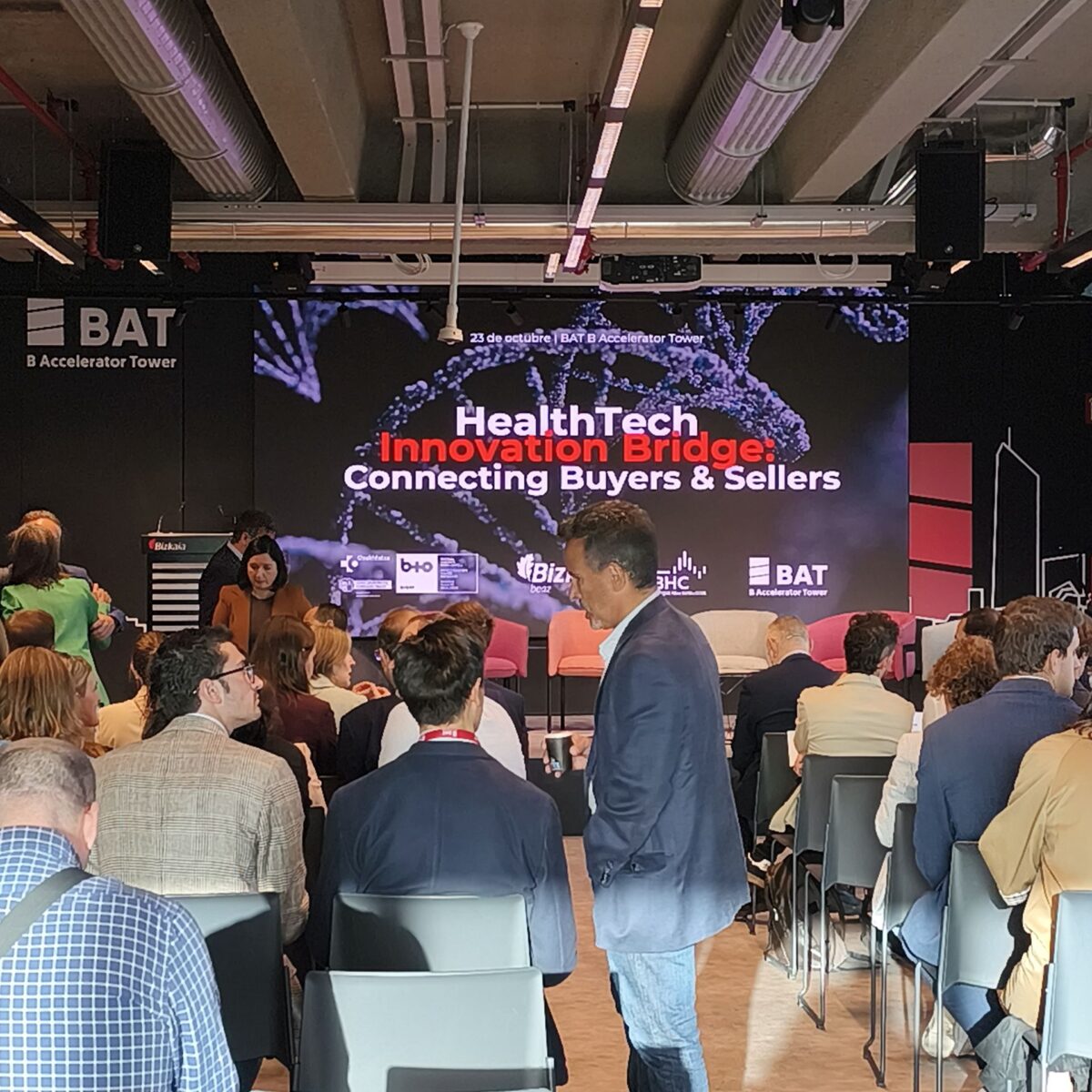Bilbao, October 24, 2025
The HealthTech Innovation Bridge: Connecting Buyers & Sellers event, organized by BAT B Accelerator Tower, Basque Health Cluster, BIOEF, and Beaz Bizkaia, brought together leaders from the healthcare and technology sectors in Bilbao yesterday to discuss the adoption of innovation in the public health system and Public Procurement of Innovation (PPI) as a strategic tool to enable early access of new technologies to patients.
The meeting was consolidated as a space for exchange and collaboration among public administrations, technology companies, and international startups, focusing on the processes of evaluation, incorporation, and financing of innovative medicines and healthcare solutions.
Evaluation and Procurement of Healthcare Innovation
During the first roundtable, experts from the public sector and health technology assessment discussed the main challenges in evaluating and financing new healthcare technologies. The evolution of evaluation processes was highlighted, exemplified by CEVIME, which presented its model of therapeutic positioning reports used to guide both clinical decision-making and health policy. Additionally, work is underway on a European joint assessment model, which includes various stages—technology evaluation, drug positioning, and a medical technology assessment board—with the aim of harmonizing criteria among countries.
Participants agreed on the coordination challenge resulting from the loss of technical and collaborative structures in recent years, which has hindered fast and efficient decision-making. In this context, Iñaki Betolaza, Director of Pharmacy at the Basque Government, emphasized the importance of identifying which innovations bring real value to patients and enabling their early introduction in hospitals through a results-based approach, prioritizing technologies that have a tangible impact on clinical care.
Likewise, Nora Ibargoyen (OSTEBA – BIOEF) stressed the need to apply rigorous methodologies that include the consideration of environmental impact and allow for coordinated assessments at the European level, reinforcing the transparency and efficiency of the process. Flora Pérez (IDIVAL) highlighted the importance of designing procurement procedures that go beyond purely financial criteria, incorporating patient participation, outcome-based agreements, risk-sharing mechanisms, and data management tools that enable effective monitoring of innovation without compromising privacy.
Effective Implementation of Innovative Solutions
The second roundtable focused on the challenges of integrating innovative solutions within the healthcare system, addressing how companies and startups can overcome barriers to access and scalability. Experts agreed that one of the key factors is the existence of more predictable regulatory frameworks, allowing for safer and more anticipatory planning of new technology introductions.
They also emphasized the importance of defining what kind of evidence is relevant for evaluating a medicine or technology, incorporating broader indicators than those from traditional clinical trials. This includes recognizing that the same drug may have applications for different diseases, as well as the need for real-world data to reflect population-level health impacts. The patient voice was recognized as a critical element that must be integrated from the early stages of development, through technology evaluation and prioritization, to final implementation within healthcare systems.
Participants highlighted that fostering true innovation in healthcare requires boldness—taking risks with new solutions, testing alternative evaluation models, and designing pioneering adoption strategies—while maintaining a focus on patient value and system sustainability.
The session also underscored the importance of multisector collaboration among administrations, companies, research centers, and startups, identifying such cooperation as essential to overcoming access barriers and ensuring that innovation reaches patients effectively. Novo Nordisk, Boehringer Ingelheim, IRISBOND, Histocell, and Vicomtech shared their experiences integrating their solutions, illustrating how the combination of industrial expertise, research, and technology can facilitate sustainable and scalable adoption of health innovation.
Together, both panels highlighted the need to align evaluation, procurement, and implementation, integrating criteria of clinical value, sustainability, patient participation, and bold innovation—positioning Euskadi as a benchmark in the connection between science, technology, and healthcare innovation.
Event Conclusion
HealthTech Innovation Bridge 2025 reaffirmed Euskadi’s leadership as a hub for healthcare and technological innovation, fostering collaboration between science, technology, and the health system.
The event emphasized the importance of enabling early adoption of health outcomes–based innovation, as well as designing more agile, sustainable, and patient-centered evaluation and procurement processes, and developing data management and impact monitoring tools that benefit both public administration and industry.
The event strengthened Bilbao and Bizkaia’s position as reference points in health innovation, driving technology transfer projects, public–private collaboration, and business opportunities for a more digital, innovative, and sustainable healthcare system.


